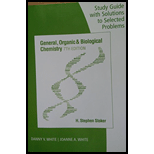
Concept explainers
(a)
Interpretation:
The type of reaction that occurs in step 1 of a turn of the
Concept Introduction:
The
Dehydrogenation reaction, hydration reaction, and thiolysis reactions occur in the
In dehydrogenation reaction, hydrogen molecule
(a)
Answer to Problem 25.30EP
Dehydrogenation reaction occurs in step 1 of a turn of the
Explanation of Solution
In step 1 of a turn of the

The hydrogen molecule is removed from
(b)
Interpretation:
The type of reaction that occurs in step 2 of a turn of the
Concept Introduction:
The
Dehydrogenation reaction, hydration reaction, and thiolysis reactions occur in the
In dehydrogenation reaction, hydrogen molecule
(b)
Answer to Problem 25.30EP
Hydration reaction occurs in step 2 of a turn of the
Explanation of Solution
In step 2, a water
The reaction for step 2 is as follows:

A water molecule is added in step 2, therefore; the reaction in step 2 of a turn of the
(c)
Interpretation:
The type of reaction that occurs in step 3 of a turn of the
Concept Introduction:
The
Dehydrogenation reaction, hydration reaction, and thiolysis reactions occur in the
In dehydrogenation reaction, hydrogen molecule
(c)
Answer to Problem 25.30EP
Dehydrogenation reaction occurs in step 3 of a turn of the
Explanation of Solution
In step 3 of a turn of the

The hydrogen
(d)
Interpretation:
The type of reaction that occurs in step 4 of a turn of the
Concept Introduction:
The
Dehydrogenation reaction, hydration reaction, and thiolysis reactions occur in the
In dehydrogenation reaction, hydrogen molecule
(d)
Answer to Problem 25.30EP
Thiolysis reaction occurs in step 4 of a turn of the
Explanation of Solution
In step 4 of a turn of the

The carbon-carbon bond in
Want to see more full solutions like this?
Chapter 25 Solutions
Study Guide with Selected Solutions for Stoker's General, Organic, and Biological Chemistry, 7th
- Explain why the total E in an Einstein depends on the frequency or wavelength of the light.arrow_forwardIf the dissociation energy of one mole of O2 is 5.17 eV, determine the wavelength that must be used to dissociate it with electromagnetic radiation. Indicate how many Einstein's of this radiation are needed to dissociate 1 liter of O2 at 25°C and 1 atm of pressure.Data: 1 eV = 96485 kJ mol-1; R = 0.082 atm L K-1; c = 2.998x108 m s-1; h = 6.626x10-34 J s; NA = 6.022x 1023 mol-1arrow_forwardIndicate the number of Einsteins that are equivalent to 550 kJ mol⁻¹ of absorbed energy (wavelength 475 nm).arrow_forward
- Indicate the number of einsteins that are equivalent to 550 kJ mol⁻¹ of absorbed energy?arrow_forwardA unit used in photochemistry is the einstein. If 400 kJ mol-1 of energy has been absorbed, how many einsteins is this equivalent to?arrow_forwardFor the condensation reaction between Alanine and histidine write the amididation reaction mechanism using arrows then write the three letter code for the product of the reaction and the one letter code for the product of the reaction.arrow_forward
- Name the following molecules using iupacarrow_forwardWrite the amididation reaction mechanism of a-aminophenol and acetic acid to produce acetaminophenarrow_forwardFor the condensation reaction between Alamine and histamine, please help me write the amididation reaction mechanism. Then write the three letter code for the product of the reaction, then write the one letter code for the product of the reaction. arrow_forward
 Chemistry for Today: General, Organic, and Bioche...ChemistryISBN:9781305960060Author:Spencer L. Seager, Michael R. Slabaugh, Maren S. HansenPublisher:Cengage Learning
Chemistry for Today: General, Organic, and Bioche...ChemistryISBN:9781305960060Author:Spencer L. Seager, Michael R. Slabaugh, Maren S. HansenPublisher:Cengage Learning Chemistry In FocusChemistryISBN:9781305084476Author:Tro, Nivaldo J., Neu, Don.Publisher:Cengage Learning
Chemistry In FocusChemistryISBN:9781305084476Author:Tro, Nivaldo J., Neu, Don.Publisher:Cengage Learning
 General, Organic, and Biological ChemistryChemistryISBN:9781285853918Author:H. Stephen StokerPublisher:Cengage Learning
General, Organic, and Biological ChemistryChemistryISBN:9781285853918Author:H. Stephen StokerPublisher:Cengage Learning Organic And Biological ChemistryChemistryISBN:9781305081079Author:STOKER, H. Stephen (howard Stephen)Publisher:Cengage Learning,
Organic And Biological ChemistryChemistryISBN:9781305081079Author:STOKER, H. Stephen (howard Stephen)Publisher:Cengage Learning, Introduction to General, Organic and BiochemistryChemistryISBN:9781285869759Author:Frederick A. Bettelheim, William H. Brown, Mary K. Campbell, Shawn O. Farrell, Omar TorresPublisher:Cengage Learning
Introduction to General, Organic and BiochemistryChemistryISBN:9781285869759Author:Frederick A. Bettelheim, William H. Brown, Mary K. Campbell, Shawn O. Farrell, Omar TorresPublisher:Cengage Learning





